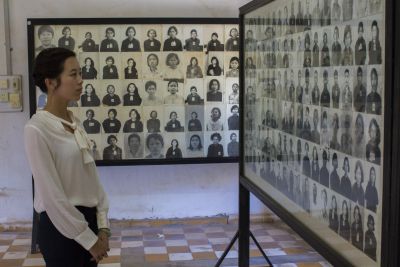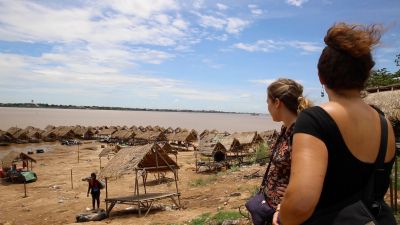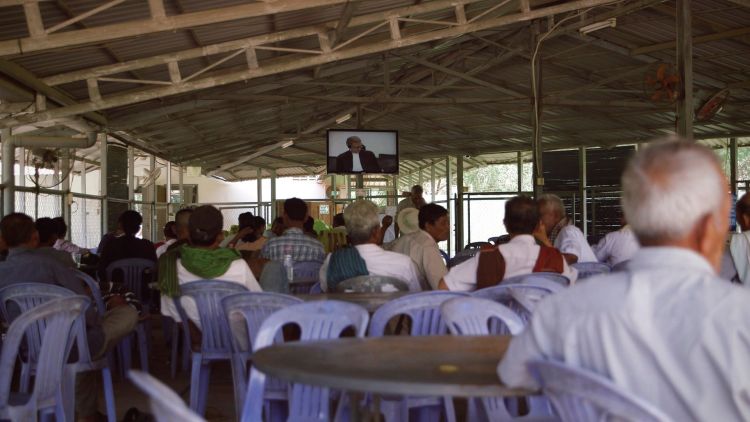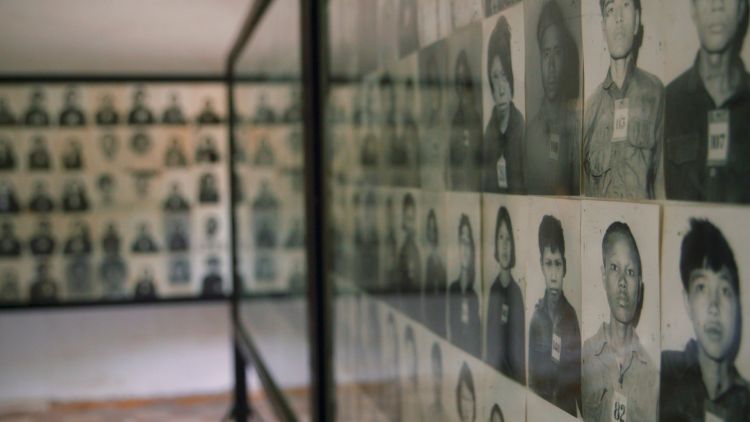It’s 82 degrees and muggy at 8 a.m. in Phnom Penh, Cambodia’s vibrant and crowded capital city. There is a steady buzz in the air as tuk-tuks and motos whiz along the street. Two Stanford undergraduate students hop out of a van as part of an international team of trial monitors.
The students – Alina Utrata and Olina Chau – along with fellow student Quito Tsui, spent last summer interning with Stanford’s WSD Handa Center for Human Rights and International Justice in Cambodia through support from the Stanford Global Studies Internship program, which sends more than 80 students to over 20 locations around the world each summer to pursue internships in a variety of fields.
They enter the security line and proceed past the dozens, sometimes hundreds, of Cambodians who have gathered to watch the day’s proceedings. The students then settle into the media room where they will spend the day monitoring Case 002 at the Extraordinary Chambers in the Courts of Cambodia (ECCC). The ECCC was established in 2003 to try the senior leaders of the Khmer Rouge for crimes committed during their reign from 1975 to 1979, when about 2 million people are believed to have died from starvation, torture, execution and forced labor.
As part of its effort to engage the next generation in the promotion and protection of human rights around the world, the Handa Center has supported the court’s work from the very beginning. It has done this through trial monitoring, film and television series focused on the proceedings, community dialogues across the country and engagement with local universities. “We saw an opportunity here to play a role in enhancing the impact that the tribunal would have on Cambodian society,” said Handa Center Director David Cohen.
The Handa Center’s trial monitoring program at the ECCC provides accountability to international legal standards as well as an objective historical record of the court’s activities for researchers, legal experts and the lay public, both in Cambodia and around the world. “I think of it as being in the center of a story as it unfolds and we get to be the authors of what appears to the public,” said Chau, a sophomore from San Diego whose parents fled the violence of the Khmer Rouge regime.
One of the really special things about Stanford students is that they are not satisfied with just learning in the classroom. They want to apply that knowledge to real-world problems.
Jeremy M. Weinstein
Director of the Stanford Global Studies Division
The Handa Center also collaborates with the Tuol Sleng Genocide Museum in Phnom Penh, a UNESCO Memory of the World site. The museum’s exhibits and archives provide a factual account of Khmer Rouge-era atrocities in an effort to help both Cambodian and international visitors better understand the history of the conflict and prevent future crimes against humanity.
“Tuol Sleng is a space of education, but also a space of practical and real-life historical importance,” said Tsui, a junior political science major who interned at the museum last summer. “My experience at Tuol Sleng has been really incredible. It’s great to be interacting on a daily basis with the people who have lived the history that we read about.”
These internships build on the academic offerings of the Handa Center, which recently launched an interdisciplinary minor in human rights to provide students with professional and practical experience in the field.
“One of the really special things about Stanford students is that they are not satisfied with just learning in the classroom. They want to apply that knowledge to real-world problems,” said Jeremy M. Weinstein, the Sakurako and William Fisher Family Director of the Stanford Global Studies Division – home to both the Global Studies internship program and the Handa Center on campus. “We’ve found that this is absolutely transformative for students’ learning experiences, but also in enabling them to think about how to pursue their career goals going forward.”

Image credit: Kurt Hickman

Image credit: Kurt Hickman

Image credit: Kurt Hickman


Image credit: Kurt Hickman

Image credit: Kurt Hickman

Image credit: Kurt Hickman

Image credit: Kurt Hickman

Image credit: Kurt Hickman

Image credit: Kurt Hickman

Image credit: Kurt Hickman

Image credit: Kurt Hickman

Image credit: Kurt Hickman

Image credit: Kurt Hickman

Image credit: Kurt Hickman

Image credit: Kurt Hickman

Image credit: Kurt Hickman

Image credit: Kurt Hickman

Image credit: Kurt Hickman

Image credit: Kurt Hickman

Image credit: Kurt Hickman

Image credit: Kurt Hickman

Image credit: Kurt Hickman

Image credit: Kurt Hickman

Image credit: Kurt Hickman

Image credit: Kurt Hickman

Image credit: Kurt Hickman

Image credit: Kurt Hickman

Image credit: Kurt Hickman

Image credit: Kurt Hickman

Image credit: Kurt Hickman

Image credit: Kurt Hickman

Image credit: Kurt Hickman

Image credit: Kurt Hickman
Putting theory into practice
Utrata, a senior majoring in history and the law, first became interested in international justice while taking Professor Norman Naimark’s history of genocide course. She spent a summer working as a research assistant for Naimark, looking at the impact of the International Criminal Tribunal for the former Yugoslavia, the court established by the United Nations to prosecute crimes committed in the Balkans in the 1990s.
So often it seems that the history book ends with the end of this terrible event, but I want to learn what happens afterward. How do communities that have suffered mass atrocity put themselves together again?
Alina Utrata
Intern, WSD Handa Center for Human Rights and International Justice
The following summer, she traveled to Sarajevo, Bosnia and Herzegovina, on another Global Studies internship, where she was able to conduct research for her honors thesis about how international tribunals and other legal mechanisms can affect post-conflict countries.
After her summer in Bosnia, Utrata was keen to further deepen her understanding of transitional justice processes by observing ongoing trial proceedings in Cambodia for the Handa Center.
“So often it seems that the history book ends with the end of this terrible event, but I want to learn what happens afterward,” Utrata said. “How do communities that have suffered mass atrocity put themselves together again? Living in Cambodia, I got to see it for myself firsthand and, crucially, whether Cambodians thought the court was a good mechanism for addressing the legacy of genocide.”
While Stanford students have a theoretical understanding of international justice gleaned from coursework, they learn how those theories can be applied on the ground in Cambodia. Tsui came to Cambodia for that very reason. “This is a society where atrocities have happened very recently and still very much mark the way in which life plays out here socially, economically and politically,” she said. “I think this internship is a way to really see that context.”
For students, the fieldwork is transformative. “The insight that they take from this experience is self-apparent,” said Penelope Van Tuyl, associate director of the Handa Center. “They come back with this incredible depth of understanding that they didn’t have before they went.”

Students and staff working in the media room at the Extraordinary Chambers in the Courts of Cambodia.

Cambodian villagers look on as the trial continues at the Extraordinary Chambers in the Courts of Cambodia.
Rights and the rule of law
To achieve progress in the area of human rights, a properly functioning legal system is indispensable, Cohen said. “The rule of law and human rights are really two sides of the same coin.”
In Cambodia, the Khmer Rouge’s desire to implement an “agrarian utopia” free of institutions resulted in a full breakdown of existing social institutions, including the judiciary. Only a handful of judicial professionals survived. The ECCC, which was set up by the Cambodian government in conjunction with the United Nations, was established not only to prosecute those most responsible for crimes against humanity, genocide and war crimes, but also to serve as a model court to help rebuild and strengthen the domestic legal system.
This special tribunal is expected to uphold international standards of justice, while imparting those norms for the national and local courts of Cambodia, said Melanie Hyde, who oversees the Handa Center’s Cambodia programs.
Go to the web site to view the video.
The Handa Center further supports these efforts by working with Cambodian universities to help educate the next generation of judicial professionals about human rights law and fair trial standards. Through the trial monitoring program, the Handa Center provides a record of the trials for research purposes and to support historical memory, accountability and increased awareness of the court’s activities.
Inside the media room, the Handa Center’s team of half a dozen trial monitors from Cambodia and other parts of the world – some full-time staff and some interns – take turns performing different tasks throughout the day, from transcribing the proceedings verbatim in both English and Khmer to updating social media. At the end of the day, a summary of the proceedings is posted to Facebook; at the end of each week, a report on the court’s activities is published.
“It is very important that we are here every day,” Utrata said. “We show that there is accountability, that people are watching, and through our roles as trial monitors we are also able to effectively liaise with the communities and let people know what is happening at the court, what the trial judgment means, and why it’s important.”
The work has shattered some preconceived ideas. “When I came here, I had this idea that the trial is more about seeking some sort of revenge,” Chau said. “Since working here, especially in the media room when you have so much access to educating youth and the general public, I’ve realized that the trials are more important for closure and for peacefulness – for being able to ensure that nothing like this ever happens again. That’s what I’m hoping to achieve here and that’s what I’ve learned the most from.”

Victims of the Khmer Rouge, Tuol Sleng Genocide Museum.

The exterior of the Tuol Sleng Genocide Museum.
Learning from the past
The international community invests hundreds of millions of dollars in justice processes such as the ECCC, but eventually the court will close when it has achieved its mandate. “What’s important to think about – and that’s part of the outreach work we are doing – is the legacy of the court,” Cohen said.
A key institution that embodies that legacy is the Tuol Sleng Genocide Museum, an important focal point in the history of the Khmer Rouge and in Cambodians’ understanding of their history, he said.
People involved with this work, they’re going to change the society. They’re going to try to prevent these kinds of atrocities from happening again.
Chhay Visoth
Director of the Tuol Sleng Genocide Museum
Built in 1965, Tuol Sleng was originally a high school, but under the Khmer Rouge regime it became “S21,” a notorious prison and torture center. Out of an estimated 20,000 people imprisoned at Tuol Sleng through the years, only a few lived to tell their story. Today, Tuol Sleng is a memorial site and museum that is meant to commemorate the tragedy that happened there and the crimes that ensued during the Khmer Rouge period more broadly.
Tsui spent her summer as a communications intern at the museum. She helped curate and draft text for the museum exhibits in an effort to enhance the educational mission of the museum and broaden its outreach. “It’s a really emotional space to be in,” she said. “Working with people every day who lived that reality is really important. It’s very special that I can share that with them, that they’re open to discussing it and having outsiders be a part of that process.”
The museum was very grateful for Tsui’s contribution over the summer, emphasized Chhay Visoth, the director of the museum, who said, “People involved with this work, they’re going to change the society. They’re going to try to prevent these kinds of atrocities from happening again.”
All photos and videos courtesy of Kurt Hickman, Stanford News Service